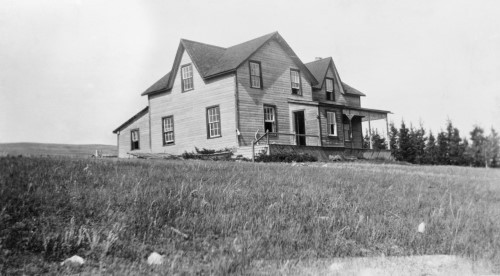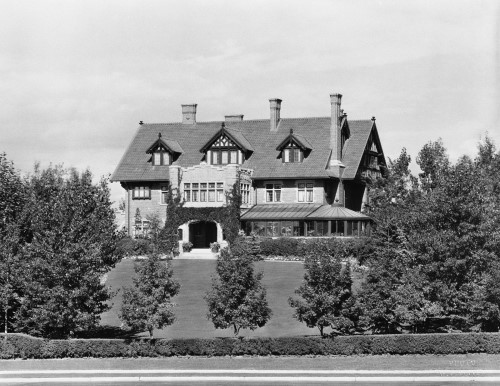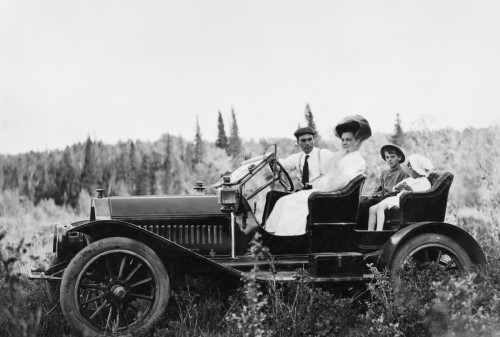Bert Stringer House
Introduction
Text-to-speech Audio
Images
Bowview Ranch, Morley, Alberta

"Queen of Mount Royal"

Bert Stringer with his sister, niece, and nephew, 1911

Arthur Stringer, 1909
.jpg)
Backstory and Context
Author-Uploaded Audio
Listen to a narration of this entry's description by Lougheed House National & Provincial Historic Site User.
Text-to-speech Audio
Here we are at 2003 8 Street Southwest, just as 8th Street climbs up the hill to Mount Royal. We are going to be looking at the home on the southwest corner [of] that intersection. This is the Bert Stringer residence, a 1909 house Calgarians used to call "the queen of Mount Royal". She is a beautiful house [and] continues to be a beautiful house.
Bert Stringer was a Calgary developer and booster in the city's Age of Optimism in the years before the Great War. He owned land in Mount Pleasant [and] he was a co-owner of a cohort trying to build the Centre Street Bridge so that people would buy his lots in Mount Pleasant. He also owned a Springbank ranch. Bert Stringer was a big spender, and spent $10,000 to build the queen of Mount Royal, back in the day when a 10-story building downtown cost around $18,000 to build - so no expense was spared on his home. Bert Stringer was also the brother of the prominent Canadian novelist and poet Arthur Stringer. Arthur visited Calgary, he never lived here, but had several family members who lived in Calgary: his brother Bert, his sister Mary [who] was married to one of the Lougheed sons, and his father had also come west from Ontario.
There is some risk being related to a novelist - there's a good chance they'll put you in one of their stories, and this is what happened to Bert Stringer. When the Age of Optimism in Calgary came to a crashing close in mid- to late 1913, so did Bert's fortunes. Now, Arthur Stringer was watching his brother's trajectory, and he thought it was pretty good fodder for fiction. He wove bits and pieces of Bert's story into his 1922 novel trilogy called Prairie Stories. The narrator of those stories is a New England socialite married to a man who wants to make it rich as an Alberta rancher. There were a lot of people who wanted to make it rich as Alberta ranchers in those days. In the final volume called The Prairie Child, the narrator's husband forces her to move to Calgary from their ranch into a Mount Royal mansion he has picked up for a song. Probably the result of a bankruptcy, that mansion came complete with a household staff, driver, butler, gardener - it was a house Stringer describes in his novel as looking oddly palatial on its opposing slope of rising ground. Clearly this house is the queen of Mount Royal. In The Prairie Child, the narrator explores Calgary, its geography, its boom-and-bust economy, and its psychology with a kind of critical detachment. It gives us a fascinating snapshot of Calgary during the Age of Optimism and over the course of its bumpy aftermath. So, we have no idea what Bert Stringer thought of Arthur popping his house and little bits and pieces of his story into a bestselling Canadian novel. I'll keep my eyes out for it but for now, we have the story and we still have this beautiful house you can stroll by and admire.
[There are] a couple of other pieces of trivia around this house that I want to tell you about. Arthur Stringer and Winnifred Reeve were friends, and Stringer visited her at Bowview Ranch in the early 1920s. Another piece of trivia: the beloved Calgary librarian Louise Riley lived in an upstairs apartment in the Stringer house in the 1930s. So that's a lovely connection to Calgary's landscape - of course, Louise Riley has a library branch named after her on the north hill.
[audio transcript]
Sources
.
Glenbow Archives and Special Collections, NA-4320-18
Glenbow Archives and Special Collections, NA-1735-1
Glenbow Archives and Special Collection, NA-5405-1
Canadian Bookman
